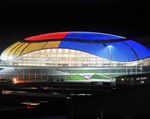SOCHI ICE SKATING RINKS - NUMERICAL SIMULATION EXPERIENCE
←
→
Page content transcription
If your browser does not render page correctly, please read the page content below
S o ch i 2 0 1 4
SOCHI ICE SKATING RINKS
NUMERICAL SIMULATION EXPERIENCE
DARIA DENISIKHINA, ANDREY KOLOSNICIN, MARIA LUKANINA
Источник: www.arch-sochi.ru
The new indoor ice skating rinks were built in Sochi for the Winter
Olympic Games 2014. The numerical simulations were carried out
for the following projects: The Iceberg Skating Palace, The Shayba
Arena and The Bolshoy Ice Dome. The aim of the simulation was
to analyze the air distribution solutions. Studies showed that the
initial design solutions did not provide the necessary parameters
of air temperature near the ice surface. The design requires
appropriate adjustments.
112 SUSTAINABLE BUILDING TECHNOLOGIES zvt. abok. r uO
ne of the major challeng-
es in the ventilation design
process is to keep different
air parameters (temperature and hu-
midity) near the ice surface and at
the tribunes. Inability to ensure the
air parameters in the vicinity of the
ice surface will result in uneven ice
melting and curvature of the surface,
which are completely unacceptable
for the Olympic venues. In addition,
the parameters of the air immedi-
ately affect the emotional and physi-
cal wellbeing of the spectators and
sportsmen.
Prediction features
of indoor air parameters
in ice arenas
Important task in ice skating rinks de-
sign is to provide them with modern
ventilation and air conditioning sys-
tems that maintained the parameters Temperature field and streamlines in the Bolshoi Ice Dome
of the air in the arena volume. The
range of these values must provide Use of simplified balance methods, ice arenas is rather sophisticated, and
comfort and match technological con- laws of jet formation, etc., for the true in most cases impossible. This is due to
ditions. description of the air behavior in the the following features:
T H E BOL S H OI I C E D OM E
Description: single building covered by
a spherical dome. The foundation for
the concept of arena is based on the
image of a frozen drop. The main color
of the dome is silver.
Location: Sochi (Russia).
General contractor: NPO «Mostovik».
General designer: design office
«Inforsproekt».
Architects: A.A. Kniazev, N.D. Cimbal.
Primary function: a multi-purpose sports,
concerts and entertainment center.
Источник: www.actualnews.org
Total area: 85 000 m 2.
Total height: 48 m (six levels including
underground).
Capacity: 12 000 seats.
Construction project: 2009–2012.
Лето 2013 З Д А Н И Я В Ы С О К И Х Т Е Х Н О Л О Г И Й 1 1 3T H E S H A Y BA AR E N A
Description: moveable
site, makes it possible to be
dismantled and transported
for post-Games use as an Ice
Palace.
Location: Sochi (Russia).
Primary function: sports
Источник: www.arch-sochi.ru
and entertainment center.
Capacity: 7 000 seats.
Total area of the ice arena:
1 800 m 2.
Construction project:
2009–2012.
•• significant non-isothermal flow in
F E ATUR E S O F N UM E RI C AL S IMULATIO N space (both in height and horizontal
directions);
•• the interaction of forced air flows
(supply jets from the nozzles, diffus-
ers) and intensive natural convection
flows (flows of warm air rising from
the spectators);
•• necessity to consider radiant compo-
nent of thermal flux at the most of
surfaces involved in heat transfer (the
ice surface and roof).
Источник: www.hctraktor.ru
These features result in the neces-
sity of using the computational flu-
id dynamics methods for analysis and
subsequent correction of design solu-
tions for air distribution in ice arenas.
That requires using the methods based
on the numerical solution of differen-
Setting the heat gain from the lighting. tial three-dimensional Navier – Stokes
This setting for the ice arena is very different from the cases without ice sur
faces. This is due to the radiant component of heat flux emitted by lighting in
equations.
visible range and partially in high frequency part of infrared range (with a co
efficient of 0,3−0,5) is absorbed by the ice plate. Absorbed heat increases the Numerical simulation
load on the chillers that support the desired temperature of the ice slab, but
should not be taken into account when calculating the load on the system serv of ice arenas
ing volume of the Arena. Therefore, the portion of the heat flux, which will be In the analysis of design solutions for
absorbed by the ice surface, should be subtracted from the total amount of
Olympic venues The Shayba Arena and
heat flux when calculating heat gain from lighting.
the The Bolshoy Ice Dome were simu-
Setting the heat transfer from the spectators. lated the mode of «hockey game» and
The ratio of radiant and convective heat gain component from people is approxi
mately 50 to 50% in the ambient temperature range 10–26 °C, which should be
for The Iceberg Skating Palace - the re-
considered while forming the simulation model. Assumptions (something fre gime was «figure skating» and «short-
quently encountered in design practice), that the heat flux from people has only track».
convective component, can lead to the formation of inappropriate flow circulation
in the volume. Spectators are the cause of signifi-
cant heat and vapor transfer into the
114 SUSTAINABLE BUILDING TECHNOLOGIES zvt. abok. r uThe Shayba Arena inside
arena area. In addition, the model takes
into account heat gain from the lighting
and information displays. Ice tempera-
ture varies with the type of event. Thus,
for competition in figure skating ice
temperature must be –4 ° C, for hockey
game –5 ° C, and for short-track compe-
titions –8 ° C.
Источник: www.ekozlov.ru
Strict requirements are placed on the
values of temperature and relative hu-
midity at 1 m above the ice surface.
The temperature in the spectator
area should be maintained in the range
of 18 to 24 °C.
N UM E RI C AL S IMULATIO N F OR T H E S H A Y BA AR E N A
Velocity field Streamlines
Temperature field Specific humidity
Лето 2013 З Д А Н И Я В Ы С О К И Х Т Е Х Н О Л О Г И Й 1 1 5the laws of jet flows) considers supply
T H E I C E B E R G S KATI N G PALA C E
jet as «warm», i.e. supernatant in the
direction of the ice field, with a corre-
sponding decreasing of jet length. How-
ever, due to considerable heat transfer
from spectators (about 1 MW), which
take place for large objects, particu-
larly Olympic venues, the temperature
in the upper zone rises above 25 °C. In
this case, the supply air from the noz-
zle (20 °C) at the beginning spreads as
«cold» in the ambient air with tempera-
ture above 25 °C, accelerating with re-
spect to isothermal jet, and then as get
closer to the ice surface begins to be-
Источник: www.sochi.com
have as a «warm» one and superna-
tants. Thus, the actual jet length signif-
icantly exceeds that value, which will
the design software give. As a result, in
practice, the jet will «bump» in the ice,
bringing the warm air and causing the
Description: moveable site, makes it possible to be dismantled and melting of the ice. It is the situation that
transported for post-Games use as a skating center in another Russian city.
was obtained during numerical simula-
The name evokes associations with the architectural shapes of the object.
tion for the initial design of the The Ice-
Location: Sochi (Russia). berg Skating Palace.
Primary function: sports and entertainment center.
Conclusions
Total area: 67 830 m 2. It is extremely difficult to predict the air
Architects: A. V. Bokov and others. temperature fields in order to take into
account when formulating the design
Capacity: 12 000 seats.
solutions and, for some cases, it is im-
Construction project: 2009–2012. possible without involving a numerical
simulation model.
Considered problem arises not only
Movement of hockey players Air supply to the ice surface zone for ice arenas, but for any projects,
leads to intensive mixing of air mass As studies have shown, the most chal- which are characterized by significant-
in the vicinity of the ice surface. lenging in the design is the organization ly uneven temperature distribution. In
This leads to the destruction of the of the air supply to the area of the ice such cases, the method of numerical
laminar boundary layer on the ice surface. The main problem while choos- simulations is a necessary tool for ana-
surface and thus increases the heat ing the equipment, for example, for the lyzing and adjusting the design solutions
transfer coefficient of the ice sur- nozzles, is that engineers usually put the for air distribution. ●
face. In combination with the inten- supply air temperature of the nozzle and
sive air mixing over ice surface this the temperature in the working area, in
leads to air temperature decrease this case near the ice field, as input pa- AUT H OR S
(compared with the case with mo- rameters for the design software. How-
tionless players) above ice. The ever, in the case of ice arenas it turns out Daria Denisikhina – head of
«Numerical department»;
mathematical model with the in- completely incorrect. Andrey Kolosnitcin – senior engineer
troduction sources of turbulent ki- So, if the supply air temperature at of «Numerical department»;
Maria Lukanina – leading engineer
netic energy and its dissipation rate the nozzles is 20 °C, and the temper- of «Numerical department»
in the players’ area was created to ature at 1 m above the ice surface is «BUREAU of TECHNICS project».
simulate this effect. 14 °C, then the design software (or by
116 SUSTAINABLE BUILDING TECHNOLOGIES zvt. abok. r uN UM E RI C AL S IMULATIO N F OR T H E I C E B E R G S KATI N G PALA C E
Temperature field in the middle section Velocity magnitude field in the middle section
Relative humidity at 1m above the ice surface
Streamlines. Initial design solution Streamlines. Proposed design solution
Лето 2013 З Д А Н И Я В Ы С О К И Х Т Е Х Н О Л О Г И Й 1 1 7You can also read



























































